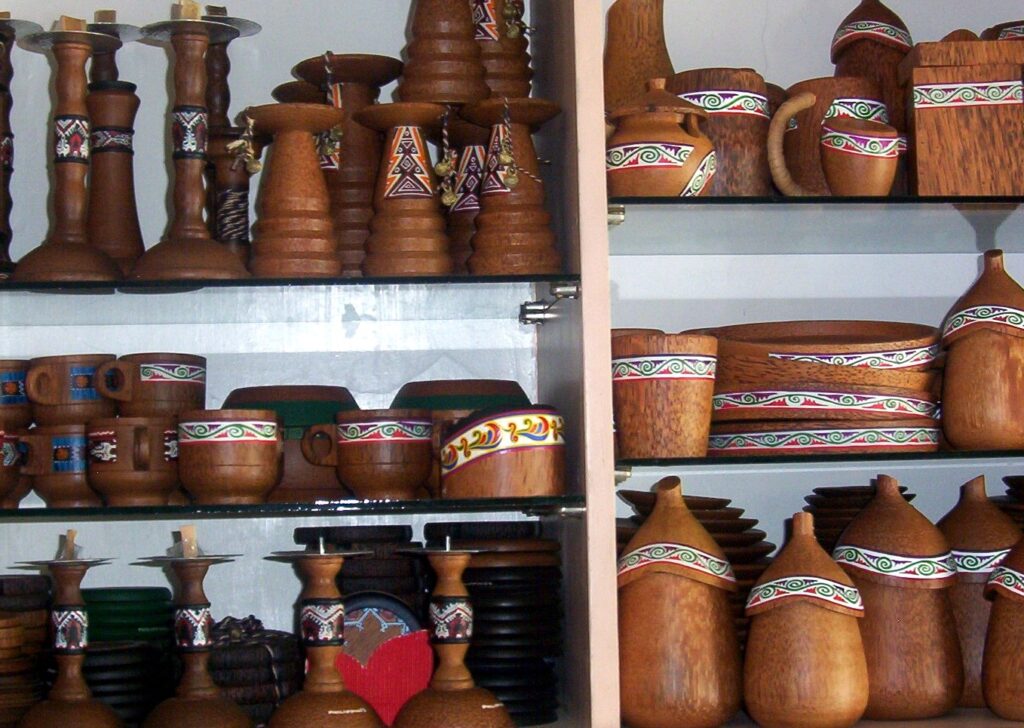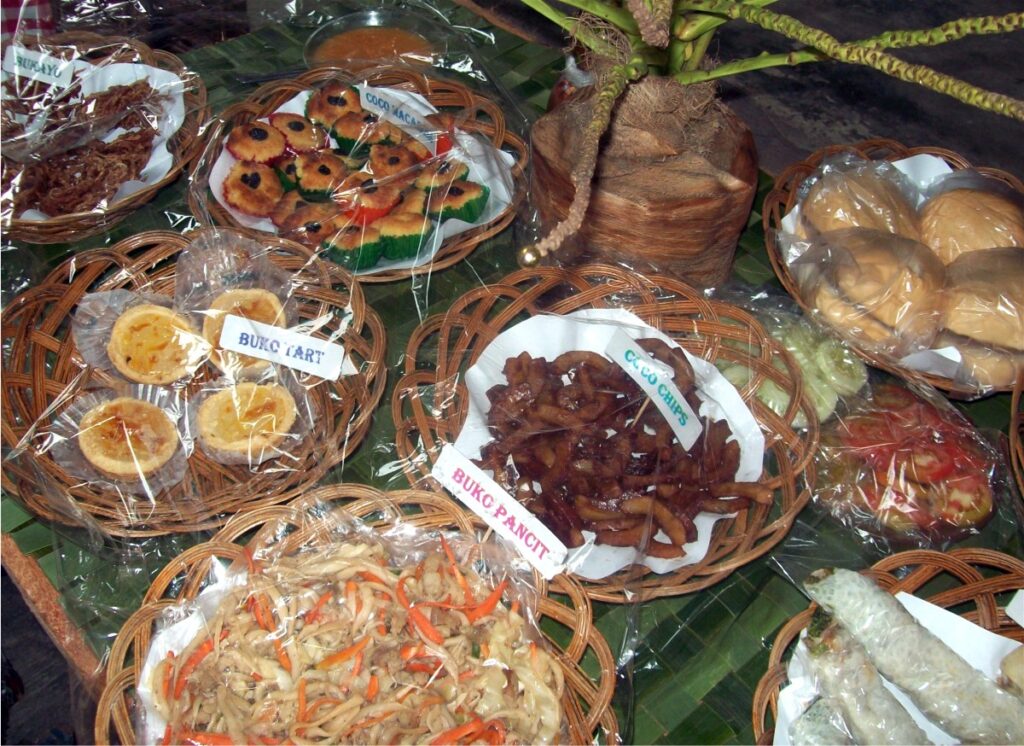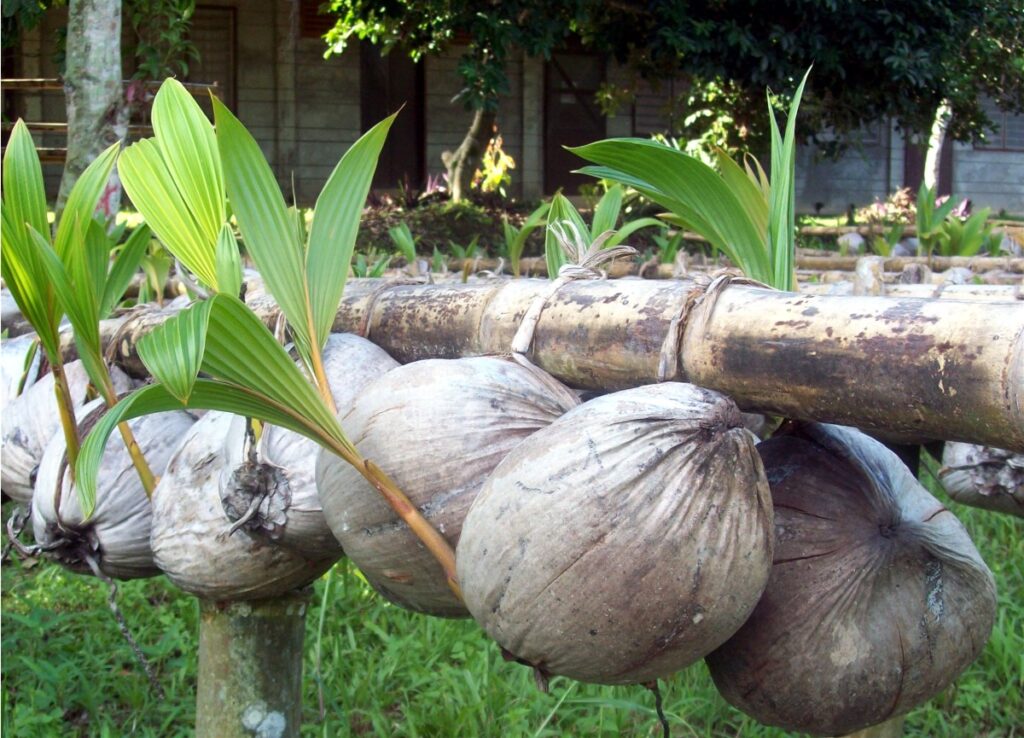Text and Photos by Henrylito D. Tacio

“The amazing thing about the coconut palm is that it provides almost all the necessities of life: food, drink, oil, medicine, fiber, timber, thatch, mats, fuel, and domestic utensils, as well as serving important environmental services such as soil erosion control in coastal regions, wind protection and shade for other crops.” That is the observation of Craig Elevitch, author of various books on tropical agriculture.
Coconut has been touted as a “lazy man’s crop.” According to an old legend, coconut is God’s gift to the lazy man. “He sleeps in the shade of the tree, is awakened when a nut falls, drinks the milk, and eats some of the meat. He then feeds the rest of the means to the chickens and cattle, which produce eggs and milk and meat, respectively. The leaves provide thatch for the roof and walls of his coconut hut, and are also woven into hats, baskets and mats.”
With multifarious uses, coconut is indeed a “tree of life.” Coconut is known scientifically as Cocos nucifera, but in the Philippines it is known as lubi (among Visayan folks), niyog (among Tagalogs and Ilokanos), ngu-ngut (Pampangueño), and ongot (Ibanag).
“The coconut industry is a pillar of Philippine agriculture,” notes Senator Edgardo J. Angara, former secretary of agriculture. “It is the oldest and most strategic industry in the country, comprising 1.14 percent of our gross domestic product, or as much as US$760 million.”
The Philippines leads the world in coconut production, dominating more than half of the global market. “Coconut itself is the top agricultural export of the Philippines, reaping an annual revenue of US$631.5 million from exports,” Angara said.
History records showed that the first impetus to coconut cultivation in the Philippines was given during the Spanish occupation. An edict was passed in 1867 by which every Filipino family was compelled to plant at least 200 square feet of coconuts.
Of the 12 million hectares of farmlands in the country, 3.1 million hectares are devoted to coconuts, according to Philippine Coconut Authority (PCA). There are around 324 million coconut trees in 79 provinces, about 85 percent of which are considered productive. Although there are only 3.5 million coconut farmers, about 25 million Filipinos are directly or indirectly dependent on the industry.
There are many products you can get from coconut. The most popular is oil, which has many uses. Studies have shown that coconut oil is good for human consumption. In a resolution commending Dr. Conrado Dayrit Jr. for his untiring and courageous effort in research on coconut oil, it was bared that coconut oil is sort of a drug “that regulates the body’s functions and defense mechanism. It restores the normal balance of tissues or cells that have become dysfunctional.”
Coconut oil is also used as an ingredient for skin care and cosmetics, and many others. It is one of two plant oils commercially produced that contains medium chain triglyceride, a formula ingredient for infant milk powder.
Recently, the government passed a bill mandating that diesel fuel be mixed with coconut oil. This attracted the attention of people from all over the world as the Philippines is the only country heavily investing in coconut fuel. Studies suggest that a 5 percent coconut blend provides optimal fuel efficiency.
After that, too much coconut oil begins to dilute the power of diesel fuel. Jun Lau, chief operating officer for Chemrez Technologies (the only factory in the country capable of converting coconut oil into biofuels) explained that what coconut oil does is help the cars run smoother. “When you put cocobiodiesel into a vehicle, you get a cleaning effect,” he explained. “It can actually work like a detergent to clean out all the carbon deposits, all the sludge, all the carbon buildup; you effectively have it melted away. So you do two things: you clean and lubricate. And effectively bring a car to its designed operating efficiency.”
Coconut milk, which is made from water and grated coconut meat, is indispensable in some Filipino food preparations. But unknown to many, electricity can be produced from coconut milk. Plants of the Philippines, published by the University of the Philippines Press, gives this information: “Bacteria implanted in the coconut milk break it down to a simpler form thus producing electricity: this mechanism is called biochemical fuel cell. The fuel cell can convert chemical energy to electrical energy by the oxidation of the fuel directly. The fuel cell and the oxidant are supplied to the cell continuously during the operation by fermentation process.”
In the past, coconut water was the “in thing.” During World War II, Japanese used coconut water to rehydrate wounded patients when there was a shortage of sterile glucose.
Coconut water is good for people with kidney problems. One Filipino doctor claimed that “two glasses of fresh buko juice every day can reduce one’s chance of having kidney or ureter stones.” Daily ‘bucolysis’ – renoculsis with ‘buko’ juice – results in a 10% reduction in size of all kidney stones.
Diabetics can also benefit from drinking coconut water. PCA informs: “Potassium content of water is remarkably high at all nut ages. Together with sodium and phosphorus, potassium content also tends to increase with the ages of the coconut to peak at nine months. This characteristic of coconut water makes it a very good drinking water for diabetics. Diabetics waking from a coma recover quickly after drinking coconut water.”
A joint study by the University of the Philippines – Philippine General Hospital and the Department of Science and Technology found that coconut water from 9-month old nuts could be safely injected into a healthy person. But here’s a warning: Patients with weak kidneys may not be able to tolerate high doses of fluid due to its high potassium content. This can lead to heart attack!
Coconut water has been used for centuries as a remedy for a lot of ailments. Occasionally by itself, or often mixed with coconut milk, it has been used to treat intestinal worms and relieves stomach and urinary problems. It is also said to diminish rashes caused by smallpox, chickenpox, and measles. It is also thought to be beneficial to the skin.
Ever heard of cocogro? Well, it is a biofertilizer made from coconut that helps crops to yield more. Dr. Lorele Trinidad said cocogro could replace inorganic fertilizers, reduce carbon emissions and mitigate the effects of nitrogen and other elements. It is developed by scientists at the National Institute of Molecular Biology and Biotechnology of the University of the Philippines at Los Baños.
“It’s a crude mixture of growth hormones. There are growth hormones good for rooting, good for shooting, so if you have vegetable seeds, the shooting is good, as well as the germination. If the germination is good, more plants are expected to grow because they already have a head start,” Dr. Trinidad said, describing the product.
According to Dr. Trinidad, cocogro has been used as a substitute growth hormone for banana-tissue culture. She said that it was a most profitable substitute since imported growth hormones are expensive, sometimes reaching P1,000 per milligram.
There are still several other uses of coconuts waiting to be discovered and tapped! — ###



